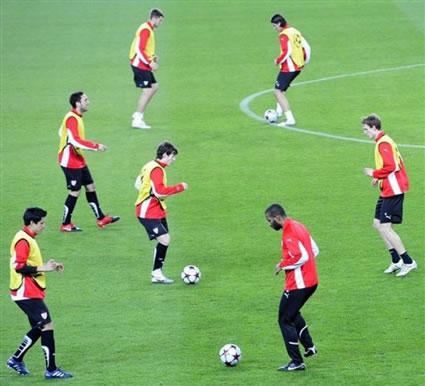Physics of a Ground Pass

One of the most fundamental elements
of a soccer player's repertoire is a simple ground
pass. Even though this may not seem like such an
intriguing aspect of the game, the physics behind
this concept is crucial.

source:
http://www.soccer-training-info.com/soccer_passing_skills.asp
Rolling Motion
Rolling motion can be described as
a combination of both translational and rotational
motion. The center of mass of the ball will move
with translational motion, while the rest of the
ball will rotate about the center of mass.

source:
http://www.physics.louisville.edu/cldavis/phys298/notes/tranrot_comb.html
The image above does an
excellent job of depicting how rolling motion is
truly a combination of both the translational motion
of the center of mass and the rotational motion of
the rest of object around that center of mass.
Lets first take a look at the velocity of the center
of mass. If the ball makes one complete rotation,
the the distance the ball has traveled is equal to
the circumference, 2R.
We can in turn find the velocity of the center of
mass by using the equation, xf-xi=vcm(tf-ti).
So by knowing the distance traveled, the equation
becomes 2piR=vcm(tf-ti).
But we know that the time it takes for an object to
travel one complete rotation is T (the period).
Substituting this into the equation and solving for
vcm gives: vcm=(2piR)/T. But
(2pi)/T is the same as the angular velocity,
w. Now we can see the the velocity of the center of
mass is:
vcm=Rw, where R is the radius of the ball
and w is the angular velocity.
Now lets take a look at the velocity of the very top
of the ball, and at the very bottom of the ball.
First, the velocity at any point, p, on the ball can
be written as:
vp=vcm+vp,
rel. Taking this into
account, for the very top of the
ball, the velocity relative to the center of
mass is Rw. This
is the same velocity that the center of mass
has, so the velocity at the top of the ball is
2vcm, or 2Rw.
Finally, lets take a look at the velocity
at the very bottom of the ball, the point that
is touching the ground, assuming there is no
slipping. Using the same principles that we did
with the top of the ball, the velocity relative
to the center of mass at the bottom of the ball
is -Rw, because relative to the center of mass,
it is moving in the negative direction. When
adding this value to the velocity of the center
of mass, we get that the velocity at the bottom
of the ball is 0. This means that for any object
that is experiencing rolling motion, without any
slipping, the point that is touching the ground
is instantaneously at rest!

source:
http://www.wallcoo.net/sport/ball/html/wallpaper18.html
|